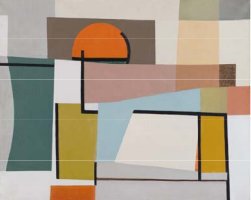Robert Breer
dal 10/6/2011 al 24/9/2011
Segnalato da
10/6/2011
Robert Breer
Baltic Centre for Contemporary Art, Gateshead
A major exhibition of the work of painter, filmmaker and sculptor Robert Breer. His first real passion, however, was the reductive purity of Piet Mondrian's grid-based abstract paintings. Moving to Paris in 1949, Breer developed his own take on hard edge abstraction, exhibiting at the Galerie Denise Rene'. He soon rejected the stability and harmony of Mondrian's compositions, introducing implied movement and free-floating lines into his paintings.

ROBERT BREER
BALTIC Centre for Contemporary Art, Gateshead and Museum Tinguely, Basel are
organising a major exhibition of the work of painter, filmmaker and sculptor Robert
Breer. Born in Detroit in 1926, Breer is one of the most ground-breaking and
celebrated animators in history. This will be his most comprehensive exhibition to
date, spanning two floors at BALTIC with work from 1950 to the present day.
The son of an amateur 3D home-movie maker and chief engineer at the Chrysler
Corporation, Breer initially studied engineering at Stanford, before switching to
painting. Early enthusiasms were a 1935 BMW open cockpit racing car and stunt flying
lessons in a bi-plane. His first real passion, however, was the reductive purity of
Piet Mondrian's grid-based abstract paintings. Moving to Paris in 1949, Breer
developed his own take on hard edge abstraction, exhibiting at the Galerie Denise
René. He soon rejected the stability and harmony of Mondrian's compositions,
introducing implied movement and free-floating lines into his paintings. His forms
became irregular and wrestled against each other, appearing in a permanent state of
unrest. Around ten canvases from the 1950s, including Composition with Three Lines,
1950, Time Out, 1953 and Three Stages Elevators, 1955 will be included. Many have
not been exhibited for several decades.
Developing the implied movement of his paintings Breer also started experimenting
with animation, first with flip books and then with film. In his first film, Form
Phases, 1952, the designs of his paintings were set into motion, morphing from one
thing into another and shifting in colour and cinematic space. Form Phases IV, 1954,
a tour de force of movement and instability sees forms, colours, lines and actions
burst, complement and contradict each other across every square inch of screen. A
tension between the moving and still image defines many of these early works:
Recreation I, 1956-57 uses a different image for every single frame (24 frames per
second), rejecting the supposed reality that traditional film represents and
revealing movement as nothing but a repetition of static film cells. As his career
progressed Breer became ever-concerned with the interplay between abstraction and
representation. Fuji, 1974 jumps from filmed footage of Breer's wife by a train
window to a rotoscoped sequence of a ticket collector and countless drawn depictions
of Mount Fuji, all of which slip back and forth into and out of abstraction. In
Swiss Army Knife with Rats and Pigeons, 1980 the functional form of the knife and
its red colour separate and dance around each other before reuniting. The exhibition
includes these and other pioneering works from 1952 into the 1990s.
BALTIC's Level 4 gallery will be devoted to another important body of Breer's work,
the motion sculptures or 'floats', begun in the 1960s. These simple, almost
minimalist forms, move at speed that is almost imperceptible before changing
direction upon a collision. Recreating the motion and flux of his films in three
dimensions, works such as Zig, 1965, Column, 1967 and Sponge, 2000 surround the
viewer, allowing form and change to be experienced in real time and space. Breer's
greatest achievement, perhaps, has been to use one force to define its opposite -
movement to counteract movement, pause to dramatise speed, and representation to
concentrate abstraction.
Organised in close collaboration with the artist, the exhibition will be the first
to bring Breer's work in all media together for several decades, revealing him to be
as vital a today as he was in the 1950s. A major publication will be produced to
accompany the exhibition.
BALTIC Centre for Contemporary Art, Gateshead (11 June - 25 September 2011)
Tinguely Museum, Basel (26 October 2011 - 29 January 2012)
BALTIC is a major international centre for contemporary art situated on the south
bank of the River Tyne in Gateshead, England. BALTIC presents a constantly changing,
distinctive and ambitious programme of exhibitions and events, and is a world leader
in the presentation, commissioning and communication of contemporary visual art.
BALTIC has welcomed over 3.9 million visitors, since opening to the public in July
2002.
For further information on the exhibition, please contact:
Ann Cooper, Head of Communications T: 0191 440 4915 E: annc@balticmill.com
For images please contact:
Nikki Johnson, Communications Assistant T: 0191 440 4912 E: nikkij@balticmill.com
Opening 11 June 2011
BALTIC Centre for Contemporary Art
Gateshead Quays - South Shore Road - Gateshead
Opening hours: Monday - Sunday 10 - 18
except Tuesdays 10.30 - 18.00
free admission



